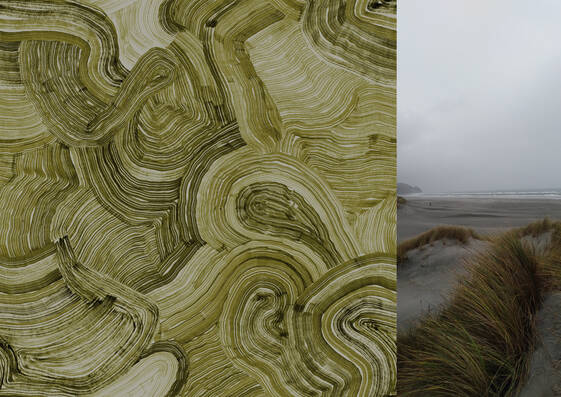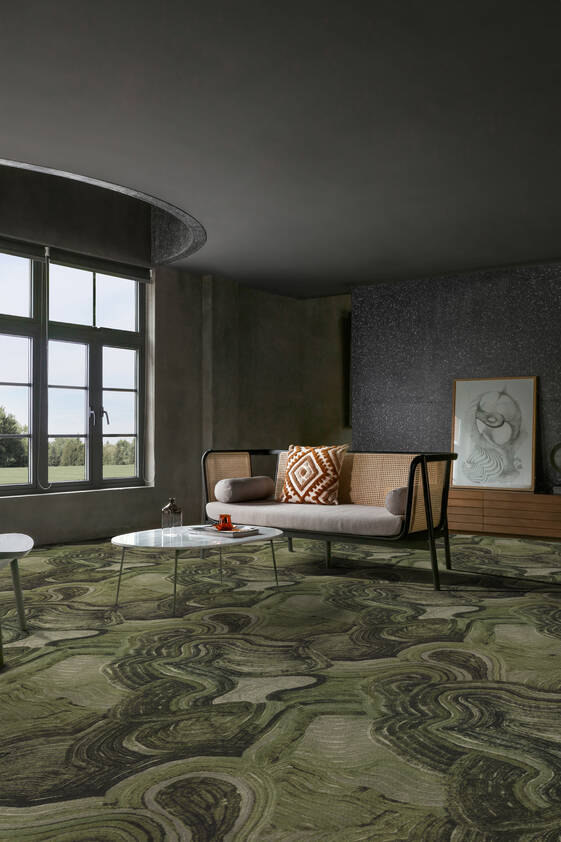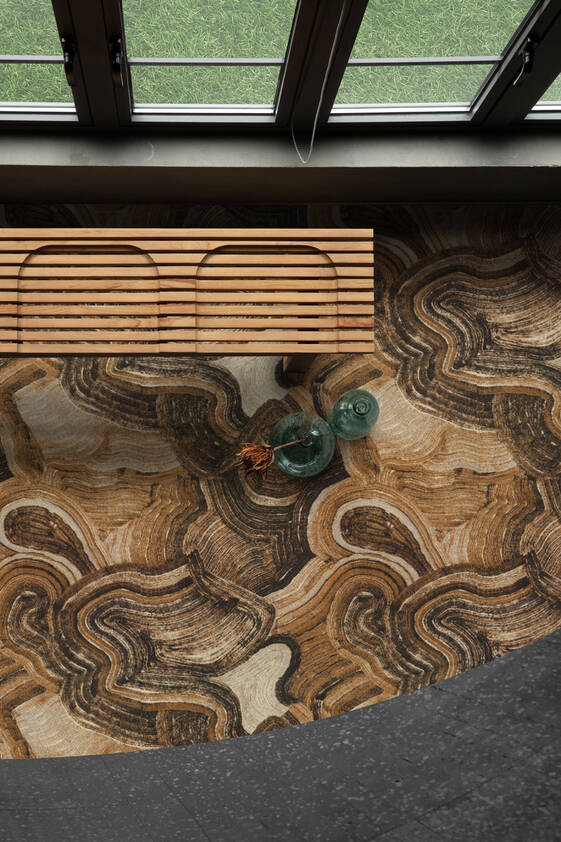Ashley Oswin talks about her design process
DINZ Interview
To The Floor - The Lifeforce

We caught up with Ashley Oswin about the process behind her award-winning design for the inaugural ‘To the Floor – The Lifeforce’ competition by Milliken and the Designers Institute of New Zealand.

When speaking of ‘circularity’, the theme of To The Floor competition, Wellington-based textile designer Ashley Oswin hints and dabbles on a few definitions, images and metaphors that she came to understand or formulate during a whirlwind tour of New Zealand’s South Island back in 2020.
Perhaps because of her current research (for a masters degree) around memories, emotional attachment and the importance of storytelling in object design, Ashley often weaves observational narrative to her creative process. There is talk of shapes — as in the ripples that form in a body of water. She hints at concepts of the circular economy and biophilia, and the effects they might have on the wellbeing of both the planet and its inhabitants. Yet, most of all, she discusses the cyclical nature of the seasons and how their perennial return is always somewhat different, changing not only themselves but the physicality of all living and inert objects.
“These are all things that us, as city dwellers, don’t get to understand”, she says, “living in the city, you never really experience the seasons the way you do when you're in the middle of the bush or in the middle of nowhere… and [while travelling] I was really struck with how circularity works there.”
This led the designer to try and synthesise all these ideas about circularity into something visual: “I wanted to do something, to draw something that captured how the landscape changed but wasn't always how we expected it to be,” she continues, “that idea evolved and I ended up looking at how the wind blows and how it shaped, over time, things like the sand dunes I had seen on my trip.”
The result was a stunning exploration of mark making, a textural drawing that is part Van Gogh’s Starry Night, part expressive brushstroke, yet with a distinct New Zealand accent.


Fast forward a few months later when a colleague from Massey University approached Ashley because she had heard of ‘To the Floor’; a design competition by flooring manufacturer Milliken and The Designers Institute of New Zealand, where the winner would work with Milliken's creative director, James Mufla, to develop a carpet tile collection that would be manufactured and sold globally earning the winner 3% on sales.
The brief for this inaugural contest was for a design inspired by the circular flow of our living systems “creating a rhythm between all living things, restoring and regenerating with each flow,” according to organisers.
“I'd never really entered a design competition before,” says Ashley, “but the reason I entered this one was because I thought the work [that came from that South Island trip] really spoke to the brief.” And that, it did. So much so that the judges gave Ashley’s design the top accolade among 58 entries and six finalists from a wide array of creative fields.
“It took a while to sink in,” says Ashley of her win, a touch of excitement still apparent in her voice. What followed, was, according to her, a deep dive into the design processes required to get a product to a manufacturing standard that would cater to a multinational market.
Ashley was swept up into Zoom meetings with various stakeholders and designers talking about her inspiration and concepts as well as how best to take her hero piece, define its main coordinates and expand it into a full-blown collection.
These were serious discussions, she comments, about the underlying narrative, about the places she visited in her road trip and what elements and ideas could be extracted to thematically and visually create a cohesive whole that was true to her original intent.
“I really got talking a bit more about the three places that really struck me the most during my trip: Farewell Spit, which is the top of the South Island where there are sand dunes and the wind and the grasses just made such beautiful patterns. Then there was Lake Tekapo, and Glenorchy where we went on a big walk around the loop track at the Glenorchy lagoon.”


Ashley was asked to create more artwork inspired by all of those memories so, over the Christmas break, “I did lots of drawing with ink and charcoal, looking at that imagery and thinking about the movement and the landscapes and the rocks.”
Those ensuing handmade pieces and the digital layers she produces from them were sent to the design team at Milliken to play with and look at her inspiration and make some repeat patterns out of them which could be translated into carpet tiles.
“They stayed pretty true to the concepts the whole way through,” she says, “they really understood the story and really wanted to honour it”.
Ashley is also quick to point out how the process was highly collaborative and respectful of her work. This, she says, was helped in part, by a strong legal agreement drafted in collaboration with the Designers Institute which aimed at protecting both Milliken as well as the winning designer’s interests, ensuring a fair and equitable usage of IP. “That's something that really appealed to me about this competition,” says Ashley, “how ethical and transparent it was in that the designs are still mine.”
After the team had agreed on a basic set of images for the likely collection, Ashley flew to Milliken's Australian HQ to work in their design studio for a couple of days.
“That was an incredibly valuable experience,” she explains, talking about the advancements in technology there which allows quick turnaround of prototypes (injecting the colours into synthetic fibres rather than dyeing and tufting). She mentions the fact that this process was also quite sustainable, allowing Milliken to manufacture almost on demand, onto blank carpet tiles, hence minimising waste.
The two days involved a myriad of discussions around colourways and texture, around multinational market segment predilections and culturally-driven trends in the flooring sector. The results were six separate patterns to a collection named Circular Relationships. Each pattern is firmly rooted in and named after a place or highlight she encountered during that fateful road trip: Dunes, Wave Break, Tussock, Loop Track, Rock Grain and Fossil Point.
“All throughout university,” says Ashley, “you're saying a design might be used in this or that way, but you never actually get to make something that does get used, you're just imagining it that way. That was a really valuable experience from this competition… actually making something that is going to be on the floor.”
Is the passive income from all sales something she is looking forward to? “That has not yet sunk in either,” she says, once again, with a small hint of excitement in her voice.
A portion of all proceeds from the Circular Relationships collection will be donated to support I AM HOPE initiatives. I AM HOPE is the youth and community focused support group for mental health and development, run by The Key to Life Charitable Trust.


